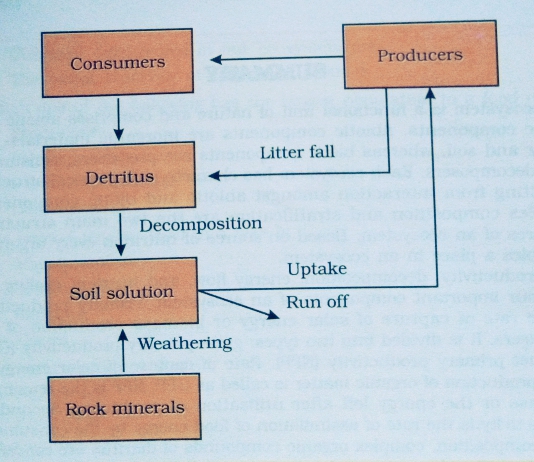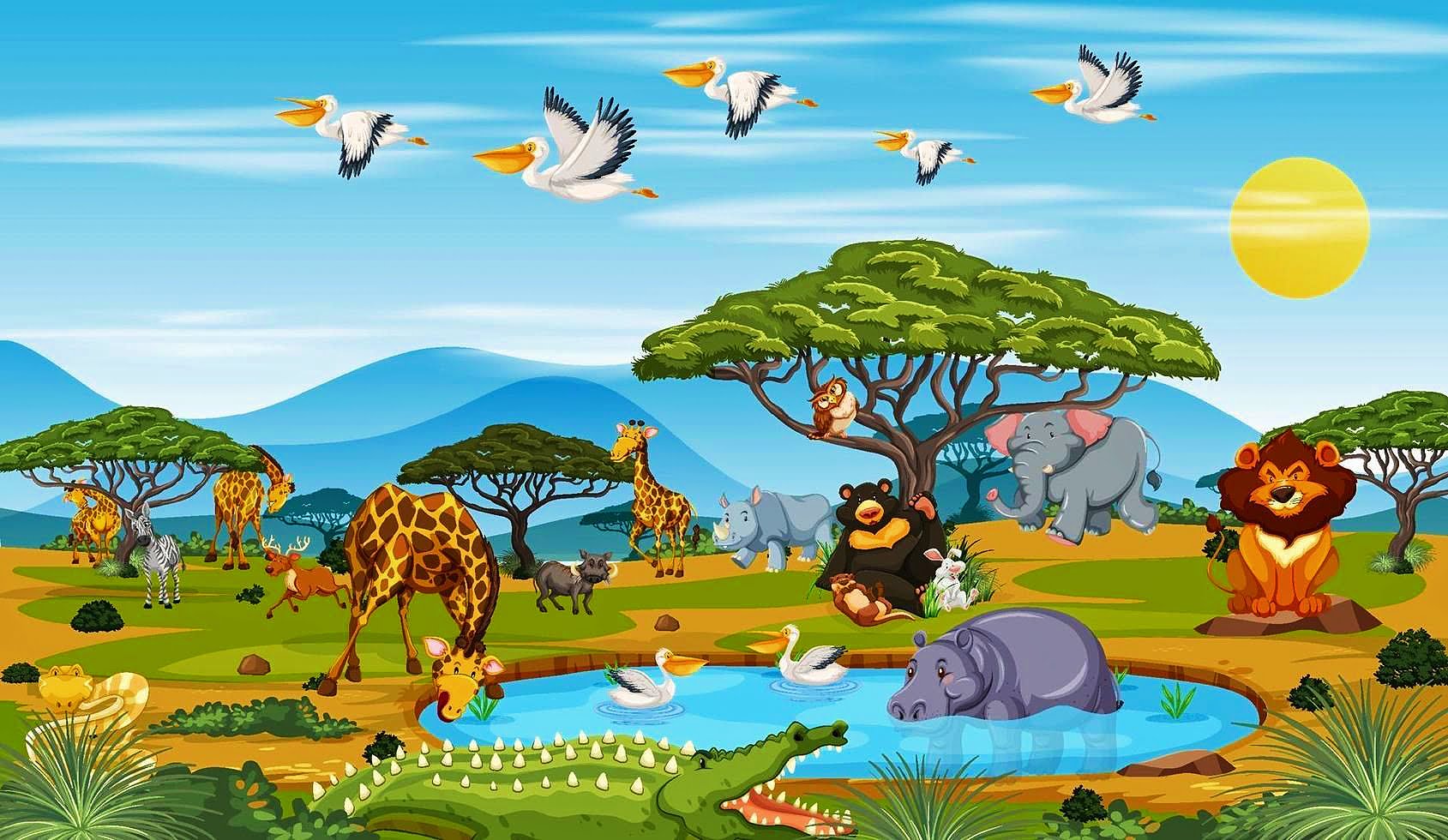Ecosystem :-
An Ecosystem can be visualised as a functional unit of nature , where living organisms interact among themselves and also with the surrounding physical environment .
- Term Ecosystem was first used in 1935 by A . G . Tansley .
- Ecosystem is greatly in size from a small pond to a largest forest or sea .
- Many ecologists regard the entire biosphere as a global ecosystem , as a composite of all local ecosystems on earth .
Components of an Ecosystem :-
1 . Biotic components .
2 . Abiotic components .
Biotic components :-
Biotic components are living things that shapes an Ecosystem .
Examples – Animals , Plants and Bacteria etc .
Classification of biotic components :-
( A ) Producers .
( B ) Consumers .
( C ) Decomposers .
Producers :-
All autotrophs are called producers . They produce own food by the photosynthesis process .
Examples – Algae , Grass , Trees .
- The green plants in the ecosystem are called producers . In ecosystem , major producers are herbaceous and Woody plants .
- Primary producers in an aquatic ecosystem are various species like phytoplankton , algae and higher plants .
Consumers :-
All animals depend on plants directly or indirectly for their food needs , they are called consumers .
Consumers can be divided into three categories .
( a ) Primary consumers :-
If the consumers feed on the producers , the plants they are called primary consumer . The primary consumers will be herbivores .
Some common herbivores are insects , birds and mammals in terrestrial ecosystem and molluscus in aquatic ecosystem .
Examples – Grasshopper , Parrot , Cows , Rabbit , Deer , Elephant , Snail etc .
Secondary consumers :-
Those animals that depend on the primary consumers for food are called secondary consumers .
Examples – Frog , Human , small fish , Birds , Snakes , Lizards etc .
- The consumers that feed on herbivores are called primary carnivores . Those animals that depend on primary level called secondary carnivores .
Tertiary consumers:-
Those animals that depend on the secondary and primary consumers for food are called tertiary consumer , they are also called top consumers .
Examples – Big fish , Carnivores Bird , Cat , Tiger , Lion , Panther etc .
Decomposers :-
- A Decomposer is an organism that decomposes or
Break down organic material such as the remains of dead organisms .
Examples – Bacteria , Fungi .
- These organisms carry out the process of decomposition which all living organisms undego after death .
- Decomposition is an important process because it allows for Organic material to be recycled in an ecosystem .
- Decomposers are also known as saprotrophs . Decomposers Secrete digestive enzymes that break down and dead materials into simple inorganic materials , which are absorbed by them .

Abiotic components :-
Abiotic components are non – living components that influence an Ecosystem .
Examples – temperature , light , water , soil etc .
Temperature :-
Temperature is the most ecologically relevant environmental factor .
- The average temperature on land varies seasonally , decreases progressively from the equator towards the poles and from planes to the mountain tops .
- There are however , unique habitats such as thermal springs and deep-sea hydrothermal vents where average temperature exceed 100⁰C .
- It is general knowledge that mango trees do not and cannot grow in temperature Countries like Canada and Germany .
Water :-
Water is the most important factor influencing the life of organisms .
- Life on earth originate in water and is unsustainable without water . Its availability is so limited in desserts that only special adaptations make it possible to live there .
- Organisms living in oceans , lakes and rivers should not face any water related problems , but it is not true . For aquatic organisms the quality ( chemical composition , pH ) of water becomes important . The salt concentration ( measured as salinity in parts per thousand ) is less than 5 in inland waters , 32 – 35 in the sea .
Light :-
Since plants produce food through photosynthesis , a process which is only possible when sunlight is available as source of energy .
- We can quickly understand the importance of light for living organisms , particularly autographs .
- Many species of small plants ( herbs and shrubs ) growing in forests are adapted to photosynthesise optimally under very low light conditions because they are constantly overshadowed by tall , canopied trees .
- Many plants are also dependent on sunlight to meet their photoperiodic requirement for Flowering .
- For many animals too , light is important in that they use the diurnal and seasonal variations in light intensity and duration as cues for timing in their foraging , reproductive and migratory activities .
Soil :-
The nature and properties of soil in different place vary . It is dependent on the climate , the weathering process , whether soil is transported or sedimentary and how soil development occurred .
*Various characteristics of the soil such as soil composition , grain size and aggregation determine the percolation and water holding capacity of the soils . These characteristics along with parameters such as pH , mineral composition and topography determined to a large extent the vegetation in any area .
Types of Ecosystem :-

Food Chain :-
Food chain is a linear chain in a food web starting from producer organisms and ending at apex Predator species like top consumer or tertiary consumers .
Examples – ( 1 ) In Grass land ecosystem :- Grass , Grasshopper , Frog , Snake and Eagle forms following food chain –
Grass → Grasshopper → Frog → Snake →Eagle .
- In a food chain , member of higher trophic level feed upon a single type of organism .
- Food chain has no effect on involving the adaptability and competitiveness of organisms .
( 2 ) In aquatic ecosystem like Pond :- Algae , Zooplankton , Small fish , Big fish and Birds ( Carnivores ) forms following food chain –
Algae → Zooplankton → Small fish → Big fish → Birds .
- The detritus food chain begins with dead organic matter . It is made up of the decomposers which are heterotrophic organisms , mainly fungi and bacteria .
Food web :-
Food web is the natural interconnection of food chains and a graphical representation of what – eat – what in an ecological community .
Example – In Grass land ecosystem :- Grass , Grasshopper , Rabbit , Mouse , Lizard , Snake , Hawk and Eagle forms following food web –

Here food chains involves –
1 . Grasses →Grasshopper →Lizard →Hawk .
2 . Grasses →Grasshopper →Hawk .
3 . Grasses →Rabbit →Hawk .
4 . Grasses →Mouse →Snake →Hawk .
5 . Grasses →Mouse →Hawk .
- In a food web , member of higher trophic level feed upon many organisms .
- Food web improve them .
Trophic levels :-
Based on the source of their food , organisms occupy a specific place in the food chain that is known as their trophic level .

- Producers belong to the first trophic level .
- The amount of energy decreases at successive trophic levels . Organisms at each trophic level depend on those at the lower trophic level for their energy demands .
- Each trophic level as a certain mass of living material at a particular time called as the standing crop and the standing crop is measured as the mass of living organisms ( biomass ) or the number in a unit area .
10% law of energy transfer :-
The number of trophic levels in the grazing food chain is restricted as the transfer of energy follows 10% law , only 10% of the energy is transferred to each trophic level from the lower trophic level .

This law was first given by Lindemann In 1942 .
Ecological pyramids :-
In a food chain , the number of organisms , it’s biomass and energy of the producers , primary consumers , secondary consumers and tertiary consumers are always a certain ratio . if we Express the energy , biomass or numbers relationship between organisms then forms a pyramidal structure , this is called ecological pyramid .
- The base of pyramid represents the producers while the apex represents the tertiary or top consumer .
- Ecological pyramids may be upright or inverted .
Types of Ecological pyramids :-
1 . Pyramid of number .
2 . Pyramid of biomass .
3 . Pyramid of energy .
Pyramid of number :-
When expressed the relationship among producer , Primary , secondary and tertiary consumer on the basis of their numbers then the forming structure is called pyramid of number .
Examples :-
- Pyramid of numbers in a Grassland ecosystem , only three top carnivores are supported in an ecosystem based on production of nearly 6 millions plants .
Pyramid of numbers may be upright or inverted .

- Pyramid of number in a Pond ecosystem –

Pyramid of biomass :-
When expressed the relationship among producer , primary , secondary and tertiary consumer on the basis of their mass or dry weight then forming pyramid structure is called pyramid of biomass .
Example : –
Pyramid of biomass in a grassland ecosystem shows a sharp decrease in biomass at higher trophic levels .
- Pyramid of biomass may upright or inverted . The pyramid of biomass in Sea is generally inverted because the Biomass of fishes far exceeds that of phytoplankton .

Pyramid of energy :-
When expressed the relationship among organisms in terms of energy then forming pyramid is called pyramid of energy .
Example : –
In every ecosystem primary producers convert only 1% of the energy in sunlight available to them into NPP ( Net primary productivity ) , forms pyramid of energy .
- Energy at a lower trophic level is always more than at a higher level .
- Pyramid of energy is always upright , can never be inverted because when energy flows from a particular trophic level to the next trophic level , some energy is always lost as heat at each step .

Structure of pond ecosystem :-

Abiotic components :- Water , Soil , Temperature , Light and Air .
Biotic components :- Aquatic plants , Zooplankton , Beetles and Small fishes , Big fishes .
Productivity :-
The rate of biomass production is called productivity .
Productivity can be divided into to two categories –
1 . Primary productivity .
2 . Secondary productivity .
Primary productivity :-
Primary productivity is defined as the amount of biomass or Organic matter produced per unit area over a time period by plants during photosynthesis .
It is expressed in terms of weight or energy .
- It is expressed in terms of g⁻² yr⁻¹ or kcal m⁻² yr⁻¹ to compare the productivity of different ecosystems .
- Primary productivity depends on the plant species inhabiting a particular area . It also depends on a variety of environmental factors , availability of nutrients and photosynthetic capacity of plants . Therefore it varies in different types of ecosystems .
- It can be divided into Gross Primary Productivity ( GPP ) and Net Primary Productivity ( NPP )
Gross primary productivity ( GPP ) :-
Gross primary productivity of an ecosystem is the rate of production of Organic matter during photosynthesis . Considerable amount of GPP is utilised by plants in respiration .
Net Primary Productivity ( NPP ) :-
Gross primary productivity minus respiration losses ( R ) is the Net Primary Productivity ( NPP ) .
NPP = GPP – R
- Net Primary Productivity is available biomass for the consumption to heterotrophs ( herbivores and decomposers ) .
- The annual Net Primary Productivity of the whole biosphere is approximately 170 million tons dry weight of organic matter .
Secondary productivity :-
Secondary productivity is defined as the rate of formation of new organic matter by consumers .
Nutrient cycling :-
The movement of nutrient elements through the various components of an ecosystem is called nutrient cycling . Another name of nutrient cycling Biogeochemical cycles .
Nutrient cycles are of two types –
( a ) Gaseous cycle :-
Examples – Nitrogen Cycle , Carbon Cycle .
( b ) Sedimentary cycle :-
Examples – Sulphur Cycle , Phosphorus Cycle .
Carbon cycle :-
Carbon constitutes 49% of dry weight of organisms and is next only to water . 71% carbon is found dissolved in Oceans . This Oceanic reservoir regulates the amount of carbon dioxide in the atmosphere . Atmosphere only contains about 1% of total Global carbon .
Fossil fuel also represent a reservoir of carbon .

Carbon cycling occurs through atmosphere , Ocean and through living and dead organisms .
- According to one estimate 4 × 10¹³ kg of Carbon is fixed in the biosphere through photosynthesis annually .
- A considerable amount of carbon returns to the atmosphere as CO₂ to respiratory activities of the Producers and Consumers .
- Decomposers also contribute substantially to CO₂ pool by their processing of Waste materials and dead organic matter of Land or Ocean .
- Some amount of the fixed carbon is lost to sediments and removed from circulation .
- Burning of wood , forest , fire and combustion of organic matter . fossil-fuel , volcanic activity are additional sources for releasing CO₂ in the atmosphere .
- Human activities and significantly influenced the carbon cycle . Rapid deforestation and massive burning of fossil fuel for energy and transport have significantly increased the rate of release of carbon dioxide into the atmosphere .
Phosphorus cycle :-
Phosphorus is a major constituent of biological membranes , nucleic acid and cellular energy transfer systems .
- Many animals also need large quantities of this element to make shells , bones and teeth .
- The natural reservoir of phosphorus is rock , which contains phosphorus in the form of phosphates . when rocks are weathered , minute amount of these phosphates dissolve in soil solution and are absorbed by the roots of the plants .

- Herbivores and other animals obtain this element from plants .
- The waste products and the dead organisms are decomposed by phosphate solubilising bacteria releasing phosphorus .
- Unlike carbon cycle , there is no respiratory release of phosphorus into atmosphere .
- The Other two major and important differences between carbon and phosphorus cycle are firstly , atmospheric inputs of phosphorus through rainfall are much smaller than carbon inputs , and secondly gaseous exchanges of phosphorus between organism and environment are negligible .




